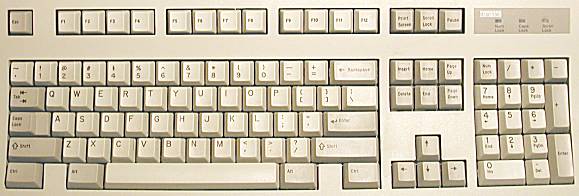In 1986, IBM introduced the IBM PC/AT Model 339. Included in this last AT-family system was the new Enhanced 101-key keyboard. Little did IBM realize at the time, perhaps, but this 101-key keyboard would become the de-facto standard for keyboards for the next decade and beyond. Even today’s Windows keyboards and fancy variants with extra buttons and keys are based on this layout.

The “Enhanced” keyboard was electrically the same as the 84-key AT keyboard, but featured a radically redesigned key layout. The major changes included these:
- Dedicated Cursor and Navigation Keys: Finally, separate keys were provided for cursor control and navigation. This enabled the numeric keyboard to be used along with the cursor and navigation keys. The cursor keys were also made into an “inverted-T” configuration for easier switching between “Up” and “Down” with a single finger.
- Relocated Function Keys: The function keys were moved from the left-hand side of the keyboard to a row along the top, and divided into groups of four for convenience. While many users had been asking for this, they found that sometimes the grass really isn’t greener on the other side of the fence, as I discuss below…
- Relocated <Esc> and <Caps Lock> Keys: The <Esc> key was moved back to the left-hand side of the keyboard, though it was placed up above the main typing area. The <Caps Lock> key was moved above the left <Shift> key.
- Extra Function Keys: Two additional function keys, <F11> and <F12> were added to the keyboard.
- Extra <Ctrl> and <Alt> Keys: Additional <Ctrl> and <Alt> keys were added on the right side of the <Space Bar>.
- Extra Numeric Keypad Keys: The numeric keypad was fitted with an additional <Enter> key, as well as the “/” (divide operator) that had been missing up to that point.
Compared the 84-key keyboard the Enhanced keyboard layout was perceived by most users to be far superior. It was an immediate hit despite its one obvious inferiority to the AT keyboard: the smaller main <Enter> key. (The <Space Bar> is also a bit smaller.) Obviously, some of the changes made with the Enhanced keyboard are undeniable. However, others are in this author’s opinion good examples of the old warning: “be careful what you ask for”…
Many PC users, after having complained for years about changes they wanted made to the PC keyboard layout, found they weren’t all that happy with them once their wish was granted! Having never complained about the issues that were changed with the Enhanced keyboard myself, I found some of the changes quite frustrating–and I later discovered that I was not alone. My personal beefs with this layout involve the locations of the following:
- Left <Ctrl> Key: With the older layout, the left-hand <Ctrl> key is readily accessible, and it is used by computer enthusiasts dozens, if not hundreds of times a day. (For example, cut, copy and paste are universal functions with standard Windows short-cuts of <Ctrl>+X, <Ctrl>+C and <Ctrl>+V respectively.) The new design puts the <Ctrl> key below the main keyboard, requiring a move of the entire left hand to reach it. And while having the <Caps Lock> key above the left <Shift> may be of use to some, I use the <Caps Lock> key maybe once or twice a month, how about you? :^) Overall, a really bad swap in my opinion.
- Function Keys: Having the function keys on the left-side of the keyboard makes them easy to reach, particularly in combination with the <Shift>, <Ctrl> and <Alt> keys. Again, these are frequently used keys which are hard to reach when above the keyboard; most combinations that used to be simple with one hand now require two. For example, a command I use frequently when writing is <Ctrl>+<F6>, the Microsoft Word (and FrontPage) function to switch between documents. Compare the motion required to type this combination on an Enhanced keyboard to what was required with the function keys on the left side and the <Ctrl> key above the <Shift> key. Also consider <Alt>+<F4>, the standard combination to close a Windows application… and so it goes.
The real irony, of course, is that the “on-screen labels corresponding to function keys”, which is what caused people to want the function keys along the top of the keyboard, disappeared from software applications many years ago! - <Esc> Key: This key is still a reach with the Enhanced design. Compare how often you use the <Esc> key in a day to the number of times you type a backwards quote or tilde! Again, a poorly-considered decision.
Despite these limitations, the 101-key keyboard remains the standard (actually, the 104-key Windows keyboard is the standard now, but the two layouts are nearly identical). Of course, countless variations of the basic design exist. A common modification is to enlarge the <Enter> key back to its “84-key layout size”, and squeeze the backslash / vertical-pipe key between the “=/+” key and the <Backspace>. An improvement in my estimation!
As for me, rather than curse the darkness, I lit a candle: I use a 124-key Gateway Anykey programmable keyboard with function keys both above and to the left of the main typing area, and a large main <Enter> key. I relocate the left <Ctrl> to where it belongs and the <Caps Lock> key somewhere out of the way where it belongs. :^) I swap the <Esc> key and the backquote/tilde key as well. Ah, freedom. :^)
| The PC Guide Site Version: 2.2.0 – Version Date: April 17, 2001 © Copyright 1997-2004 Charles M. Kozierok. All Rights Reserved. |
This is an archive of Charles M. Kozierok’s PCGuide (pcguide.com) which disappeared from the internet in 2018. We wanted to preserve Charles M. Kozierok’s knowledge about computers and are permanently hosting a selection of important pages from PCGuide.
